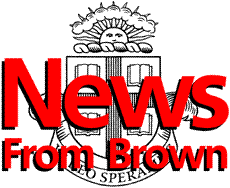
The Brown University News Bureau Distributed February 4, 1997
Contact: Linda Mahdesian

`Master of the camera'
Bell Gallery to present works by Viennese photographer Rudolf Koppitz
Rudolf Koppitz: Viennese `Master of the Camera' will be presented at the David Winton Bell Gallery at Brown University April 19 through June 1, 1997. An opening reception and talk by Jo-Ann Conklin, Bell Gallery director, will be presented at 5:30 Friday, April 18, at the Gallery, 64 College St.
PROVIDENCE, R.I. -- The David Winton Bell Gallery at Brown University will present Rudolf Koppitz: Viennese `Master of the Camera' April 19 through June 1, 1997. The opening reception will take place at 5:30 p.m. Friday, April 18, at the Gallery, 64 College St. in Providence and will feature a talk by Bell Gallery director Jo-Ann Conklin on the works of Koppitz. The exhibition and opening reception are free and open to the public.
The exhibition features 135 images and is curated by Conklin and Monika Faber, curator of the Österreichisches Fotoarchiv im Museum Moderner Kunst in Vienna, Austria. The show was organized by the Historisches Museum der Stadt Wein and The University of Iowa Museum of Art. The exhibition catalog, published by Christian Brandstätter Verlag, Vienna, includes essays on various aspects of Koppitz's work. Faber provided the primary text on Koppitz's life and work; Conklin discusses Koppitz in the context of American pictorialism; and Peter Weiermair, director of the Frankfurter Kunstverein, focuses on the photographer's male and female nude studies.
Rudolf Koppitz (1884-1936) was one of the leading representatives of art photography in Vienna between the world wars. In the United States today he is recognized as the author of the highly dramatic and sensual Secessionist photograph Bewegungsstudie ("Movement Study"). This dynamic composition remains in the minds of all who view it and it is often reproduced in both the popular and art press. In addition, the image was propelled into the spotlight when Sotheby's featured it on the cover of the spring 1995 photographic auction catalog. Bewegungsstudie subsequently brought $100,000 at auction. Yet, surprisingly, little is known about the creator of this image.
The exhibition will survey Koppitz's work, which begins with pictorialist landscapes and portraits created during the first two decades of the century, continues with figure and nude studies from the 1920s, and ends in a prodigious output of nationalistic documentation created between 1930 and the photographer's death in 1936. Koppitz's early works are marked by the influence of his teacher, the Czech symbolist photographer Karel Novák, and by the style of the Viennese Secession. Working in Vienna during the beginning of his career, Koppitz photographed the picturesque aspects of the city - St. Stephen's Cathedral, Karl's Church - and traveled to photograph Hungarian villages, fishing boats near Delft, views of Dresden and alpine landscapes. During World War I, he served as an observational photographer. (The exhibition will include a small selection of aerial photographs taken during his military service.)
In the 1920s Koppitz created his famous Bewegungsstudie, part of a series of figure studies - some clothed, others nude - which employed dancers as models. Related to these images is a group of male nudes in which the photographer served as model. An avid outdoorsman and mountaineer, Koppitz photographed himself (with the assistance of his wife, Anna) in alpine settings, at the beach and occasionally in the studio. After 1930 Koppitz devoted his energies to the depiction of the agrarian lifestyle of the Austrian peasantry. He embraced rural life as the antithesis of the alienation and political strife experienced in large cities.
The exhibition was shown at the Historisches Museum der Stadt Wien in Vienna, Austria, during the summer of 1995, and at the Frankfurter Kunstverein in Frankfurt, Germany, in the fall. The American tour of the exhibition is supported in part by a grant from the Austrian Cultural Office and includes The University of Iowa Museum of Art, Houk-Friedman Gallery in New York, the Mary and Leigh Block Gallery at Northwestern University; the David Winton Bell Gallery, and the Patrick and Beatrice Haggerty Museum of Art at Marquette University.
######